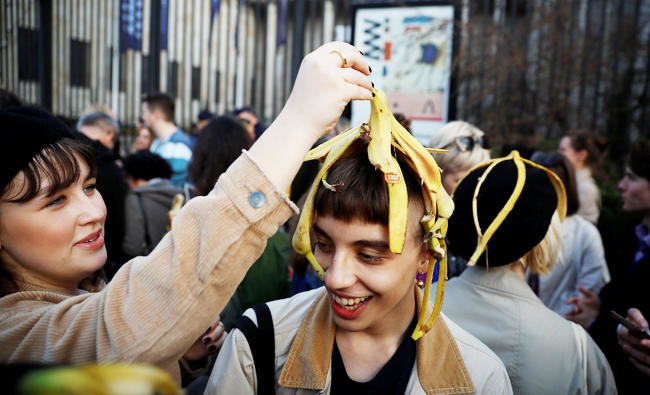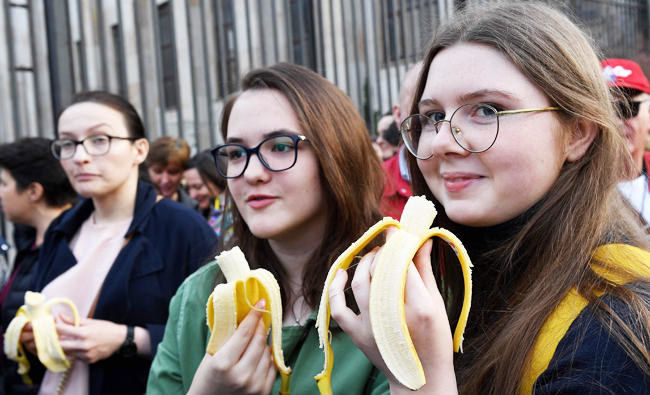WARSAW, Poland: A few hundred mostly young people jointly ate bananas outside Warsaw’s top national gallery on Monday to protest what they called censorship, after authorities removed artwork there featuring the fruit, saying it was improper.
The protest was called by artists and opposition politicians as part of their action on Facebook and Twitter of posting photos of themselves eating bananas in order to ridicule the ban. The action grew into a show of apparent criticism of the government.
The 1973 video “Consumer Art,” by prominent artist Natalia LL, showing a young woman eating a banana with great pleasure, was removed from the National Museum in Warsaw last week after the new museum head, Jerzy Miziolek, was summoned to the Ministry of Culture.
Miziolek said in an interview with the Onet.pl portal last week that he was “opposed to showing works that could irritate sensitive young people” and suggested some visitors have complained. The work had been in the gallery for many years.
A separate 2005 video by another controversial female artist, Katarzyna Kozyra, showing a woman walking two men on all fours, dressed as dogs on a lead, was also removed.
On Monday, Miziolek announced that the works would be reinstated, but only until May 6, when the whole modern art gallery is due for reorganization. Miziolek and the Ministry of Culture denied there was any pressure on the museum.
Miziolek, who was appointed to the state-run museum by the right-wing government in November, said Monday he appreciated the role of both artists in Poland’s culture, but the gallery’s limited space requires “creative changes” to the exhibition.
The dispute is the latest in a string of controversies surrounding art and culture under the conservative and nationalist government that won power in 2015.
Culture Minister Piotr Glinski has repeatedly drawn criticism for cutting subsidies to art festivals that were planning to show controversial theater plays on Catholic themes. Glinski has fired a popular theater director who criticized him as well as the director of a World War II museum, saying the exhibition did not show Poland’s suffering or heroism enough.
He recently cut funds for the European Solidarity Center, an exhibition on the Solidarity movement’s history and a culture center popular with government critics, saying its activity went beyond its history-teaching mission.
Twitter and Facebook users ridiculed the removal of the art works as narrow-minded and a case of censorship, and many posted photos of themselves enjoying bananas.
Actress Magdalena Cielecka told The Associated Press that the image she posted, of her pointing a banana at her head like a gun, was in protest against any ideological or political limits put on artists.
“An artist, to create, must be free,” Cielecka said.
At the collective banana-eating protest Monday night, some people brought more than one banana, while others put banana skins on top of their heads. A few unarmed police officers were on the scene outside the museum, which is closed on Mondays.
Senate speaker and prominent ruling Law and Justice party member Stanislaw Karczewski sought to discredit the protest, tweeting that Polish apples are tastier than bananas and have fewer calories.
“The #BananowyProtest (banana protest) is the straight road to obesity,” Karczewski tweeted.
The controversy was widely commented on in national media.
Art critics note that “Consumer Art” was a critical comment on food shortages under communist rule in the 1970s.
Ban on banana-eating artwork draws ridicule in Poland
Ban on banana-eating artwork draws ridicule in Poland

- Art critics note that “Consumer Art” was a critical comment on food shortages under communist rule in the 1970s
Trump awards medals to the Kennedy Center honorees in an Oval Office ceremony

- Trump said they are a group of “incredible people” who represent the “very best in American arts and culture”
WASHINGTON: President Donald Trump on Saturday presented the 2025 Kennedy Center honorees with their medals during a ceremony in the Oval Office, hailing the slate of artists he was deeply involved in choosing as “perhaps the most accomplished and renowned class” ever assembled.
This year’s recipients are actor Sylvester Stallone, singers Gloria Gaynor and George Strait, the rock band Kiss and actor-singer Michael Crawford.
Trump said they are a group of “incredible people” who represent the “very best in American arts and culture” and that, “I know most of them and I’ve been a fan of all of them.”
“This is a group of icons whose work and accomplishments have inspired, uplifted and unified millions and millions of Americans,” said a tuxedo-clad Trump. “This is perhaps the most accomplished and renowned class of Kennedy Center Honorees ever assembled.”
Trump’s takeover of the Kennedy Center
Trump ignored the Kennedy Center and its premier awards program during his first term as president. But the Republican has instituted a series of changes since returning to office in January, most notably ousting its board of trustees and replacing them with GOP supporters who voted him in as chairman of the board.
Trump also has criticized the center’s programming and its physical appearance, and has vowed to overhaul both.
The president placed around each honoree’s neck a new medal that was designed, created and donated by jeweler Tiffany & Co., according to the Kennedy Center and Trump.
It’s a gold disc etched on one side with the Kennedy Center’s image and rainbow colors. The honoree’s name appears on the reverse side with the date of the ceremony. The medallion hangs from a navy blue ribbon and replaces a large rainbow ribbon decorated with three gold plates that rested on the honoree’s shoulders and chest and had been used since the first honors program in 1978.
Trump honors the honorees
Strait, wearing a cowboy hat, was first to receive his medal. When the country singer started to take off the hat, Trump said, “If you want to leave it on, you can. I think we can get it through.” But Strait took it off.
The president said Crawford was a “great star of Broadway” for his lead role in the long-running “Phantom of the Opera.” Of Gaynor, he said, “We have the disco queen, and she was indeed, and nobody did it like Gloria Gaynor.”
Trump was effusive about his friend Stallone, calling him a “wonderful” and “spectacular” person and “one of the true, great movie stars” and “one of the great legends.”
Kiss is an “incredible rock band,” he said.
Songs by honorees Gaynor and Kiss played in the Rose Garden just outside the Oval Office as members of the White House press corps waited nearby for Trump to begin the ceremony.
The president president said in August that he was “about 98 percent involved” in choosing the 2025 honorees when he personally announced them at the Kennedy Center, the first slate chosen under his leadership. The honorees traditionally had been announced by press release.
It was unclear how they were chosen. Before Trump, it fell to a bipartisan selection committee.
“These are among the greatest artists, actors and performers of their generation. The greatest that we’ve seen,” Trump said. “We can hardly imagine the country music phenomena without its king of country, or American disco without its first lady, or Broadway without its phantom — and that was a phantom, let me tell you — or rock and roll without its hottest band in the world, and that’s what they are, or Hollywood without one of its greatest visionaries.”
“Each of you has made an indelible mark on American life and together you have defined entire genres and set new standards for the performing arts,” Trump said.
Trump also attended an annual State Department dinner for the honorees on Saturday. In years past, the honorees received their medallions there but Trump moved the ceremony to the White House.
Trump to host the Kennedy Center Honors
Meanwhile, the glitzy Kennedy Center Honors program and its series of tribute speeches and performances for each recipient is set to be taped on Sunday at the performing arts center for broadcast later in December on CBS and Paramount+. Trump is to attend the program for the first time as president, accompanied by his wife, first lady Melania Trump.
The president said in August that he had agreed to host the show, and he seemed to confirm on Saturday that he would do so, predicting that the broadcast would garner its highest ratings ever as a result. Presidents traditionally attend the program and sit with the honorees in the audience. None has ever served as host.
He said he looked forward to Sunday’s celebration.
“It’s going to be something that I believe, and I’m going to make a prediction: this will be the highest-rated show that they’ve ever done and they’ve gotten some pretty good ratings, but there’s nothing like what’s going to happen tomorrow night,” Trump said.
The president also swiped at late-night TV show host Jimmy Kimmel, whose program was briefly suspended earlier this year by ABC following criticism of his comments related to the killing of conservative activist Charlie Kirk in September.
Kimmel and Trump are sharp critics of each other, with the president regularly deriding Kimmel’s talent as a host. Kimmel has hosted the Primetime Emmy Awards and the Academy Award multiple times.
Trump said he should be able to outdo Kimmel.
“I’ve watched some of the people that host. Jimmy Kimmel was horrible,” Trump said. “If I can’t beat out Jimmy Kimmel in terms of talent, then I don’t think I should be president.”














